2011 INFINITI QX56 tires
[x] Cancel search: tiresPage 4263 of 5598
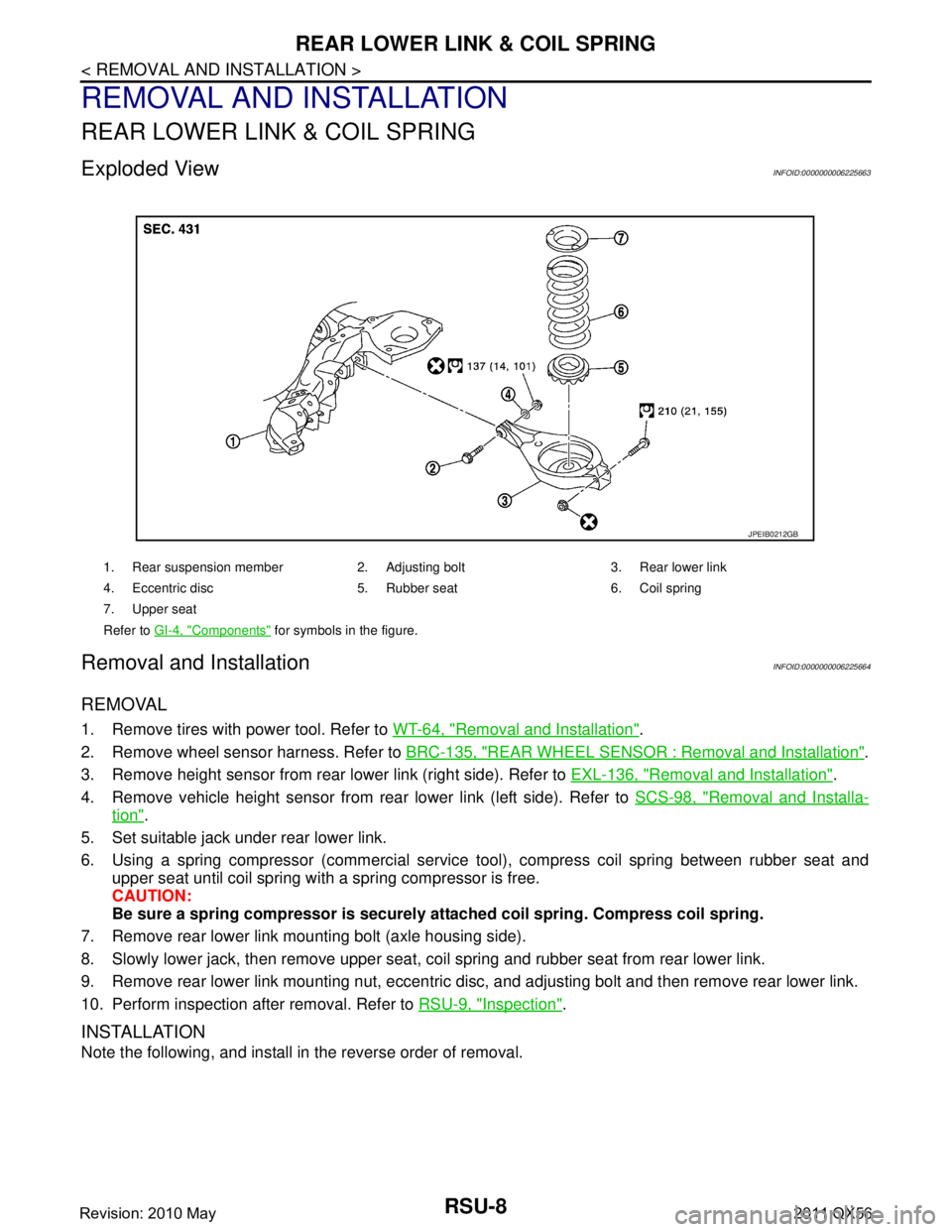
RSU-8
< REMOVAL AND INSTALLATION >
REAR LOWER LINK & COIL SPRING
REMOVAL AND INSTALLATION
REAR LOWER LINK & COIL SPRING
Exploded ViewINFOID:0000000006225663
Removal and InstallationINFOID:0000000006225664
REMOVAL
1. Remove tires with power tool. Refer to WT-64, "Removal and Installation".
2. Remove wheel sensor harness. Refer to BRC-135, "
REAR WHEEL SENSOR : Removal and Installation".
3. Remove height sensor from rear lower link (right side). Refer to EXL-136, "
Removal and Installation".
4. Remove vehicle height sensor from rear lower link (left side). Refer to SCS-98, "
Removal and Installa-
tion".
5. Set suitable jack under rear lower link.
6. Using a spring compressor (commercial service tool), compress coil spring between rubber seat and upper seat until coil spring with a spring compressor is free.
CAUTION:
Be sure a spring compressor is securely at tached coil spring. Compress coil spring.
7. Remove rear lower link mounting bolt (axle housing side).
8. Slowly lower jack, then remove upper seat, co il spring and rubber seat from rear lower link.
9. Remove rear lower link mounting nut, eccentric disc, and adjusting bolt and then remove rear lower link.
10. Perform inspection after removal. Refer to RSU-9, "
Inspection".
INSTALLATION
Note the following, and install in the reverse order of removal.
1. Rear suspension member 2. Adjusting bolt 3. Rear lower link
4. Eccentric disc 5. Rubber seat 6. Coil spring
7. Upper seat
Refer to GI-4, "
Components" for symbols in the figure.
JPEIB0212GB
Revision: 2010 May2011 QX56
Page 4264 of 5598
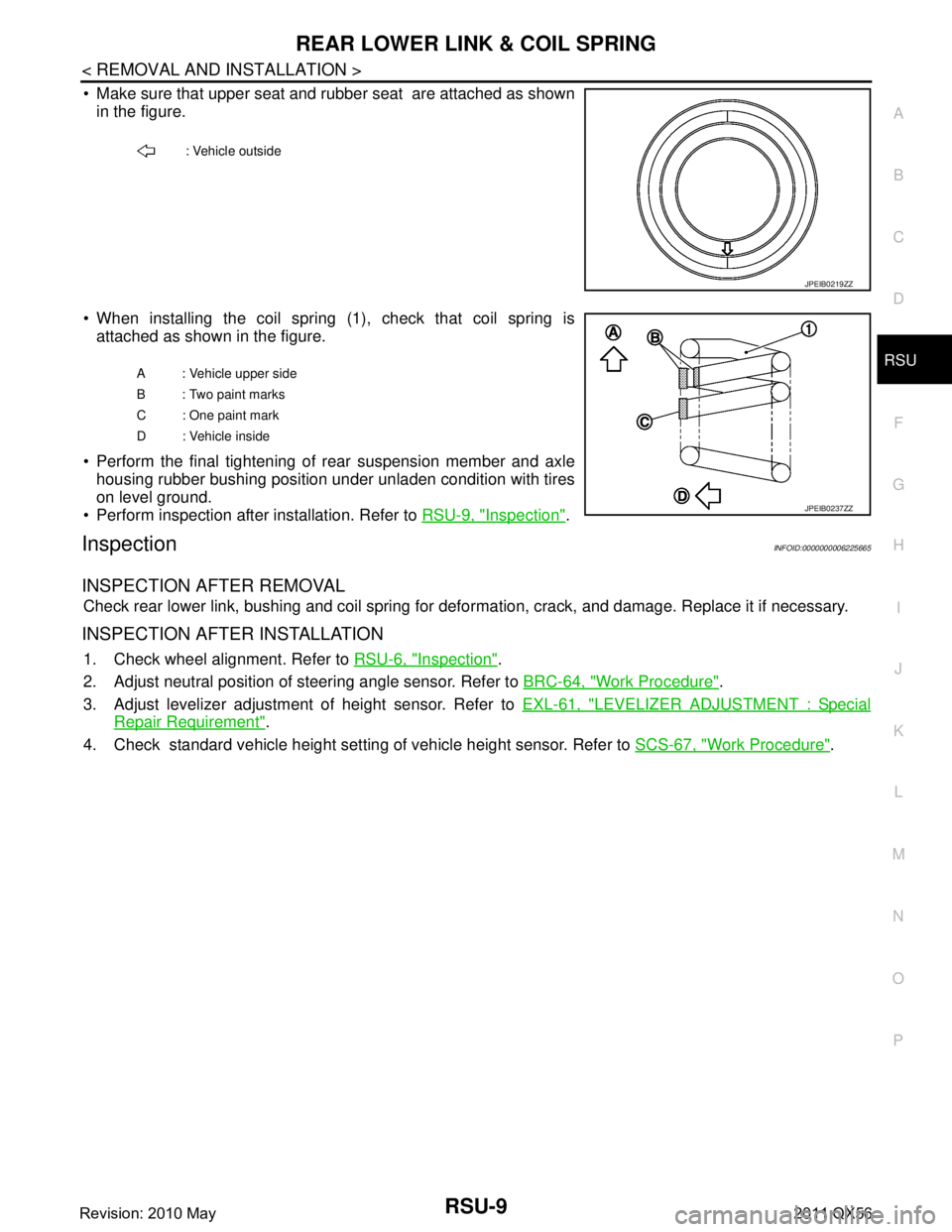
REAR LOWER LINK & COIL SPRINGRSU-9
< REMOVAL AND INSTALLATION >
C
DF
G H
I
J
K L
M A
B
RSU
N
O P
Make sure that upper seat and rubber seat are attached as shown in the figure.
When installing the coil spring (1), check that coil spring is attached as shown in the figure.
Perform the final tightening of rear suspension member and axle housing rubber bushing position under unladen condition with tires
on level ground.
Perform inspection after installation. Refer to RSU-9, "
Inspection".
InspectionINFOID:0000000006225665
INSPECTION AFTER REMOVAL
Check rear lower link, bushing and coil spring for defor mation, crack, and damage. Replace it if necessary.
INSPECTION AFTER INSTALLATION
1. Check wheel alignment. Refer to RSU-6, "Inspection".
2. Adjust neutral position of steering angle sensor. Refer to BRC-64, "
Work Procedure".
3. Adjust levelizer adjustment of height sensor. Refer to EXL-61, "
LEVELIZER ADJUSTMENT : Special
Repair Requirement".
4. Check standard vehicle height setting of vehicle height sensor. Refer to SCS-67, "
Work Procedure".
: Vehicle outside
JPEIB0219ZZ
A : Vehicle upper side
B : Two paint marks
C : One paint mark
D : Vehicle inside
JPEIB0237ZZ
Revision: 2010 May2011 QX56
Page 4266 of 5598

REAR SHOCK ABSORBERRSU-11
< REMOVAL AND INSTALLATION >
C
DF
G H
I
J
K L
M A
B
RSU
N
O P
Inadvertent piping removal causes fluid to splatter.
2. Remove tires with power tool. Refer to WT-64, "
Removal and Installation".
3. Remove height sensor from rear lower link (right side). Refer to EXL-136, "
Removal and Installation".
4. Remove vehicle height sensor from rear lower link (left side). Refer to SCS-98, "
Removal and Installa-
tion".
5. Remove air tube from shock absorber assembly. Refer to SCS-95, "
Removal and Installation".
6. Remove middle tube assembly from shock absorber assembly. (With HBMC) Refer to SCS-44, "
REAR
TUBE ASSEMBLY : Removal and Installation".
7. Remove shock absorber mounting bolt (lower side).
8. Remove piston rod lock nut.
9. Remove bracket, bushings, and shock absorber. (With HBMC)
10. Remove washers, bushings, and shock absorber. (Without HBMC)
11. Perform inspection after removal. Refer to RSU-11, "
Inspection and Adjustment".
INSTALLATION
Note the following, and install in the reverse order of removal.
When installing the bracket (1), check that bracket is attached as
shown in the figure. (With HBMC)
Use the holder (A) [SST: KV10109300 ( −)] and a suitable tool
(B) to tighten piston rod lock nut so that the bracket does not
become misaligned. (With HBMC)
Install air tube to shock absorber assembly. Refer to SCS-95,
"Removal and Installation".
Perform final tightening of bolts and nuts at the shock absorber
lower side (rubber bushing), under unladen conditions with tires on
level ground.
Perform inspection after installation. Refer to RSU-11, "
Inspection
and Adjustment".
After replacing the shock absorber, always follow the disposal pro- cedure to discard the shock absorber. Refer to RSU-12, "
Dis-
posal".
Inspection and AdjustmentINFOID:0000000006225668
INSPECTION AFTER REMOVAL
Check the following items, and replace the parts if necessary.
Shock absorber assembly for deformation, cracks, damage.
Piston rod on shock absorber assembly for damage, uneven wear, and distortion.
Welded and sealed areas for oil leakage.
INSPECTION AFTER INSTALLATION
1. Check wheel alignment. Refer to RSU-6, "Inspection".
2. Adjust neutral position of steering angle sensor. Refer to BRC-64, "
Work Procedure".
3. Adjust levelizer adjustment of height sensor. Refer to EXL-61, "
LEVELIZER ADJUSTMENT : Special
Repair Requirement".
4. Check standard vehicle height setting of vehicle height sensor. Refer to SCS-67, "
Work Procedure".
ADJUSTMENT AFTER INSTALLATION (WITH HBMC)
: Vehicle front
A : Frame edge line
B: Almost parallel
JPEIB0232ZZ
JPEIB0220ZZ
Revision: 2010 May2011 QX56
Page 4268 of 5598
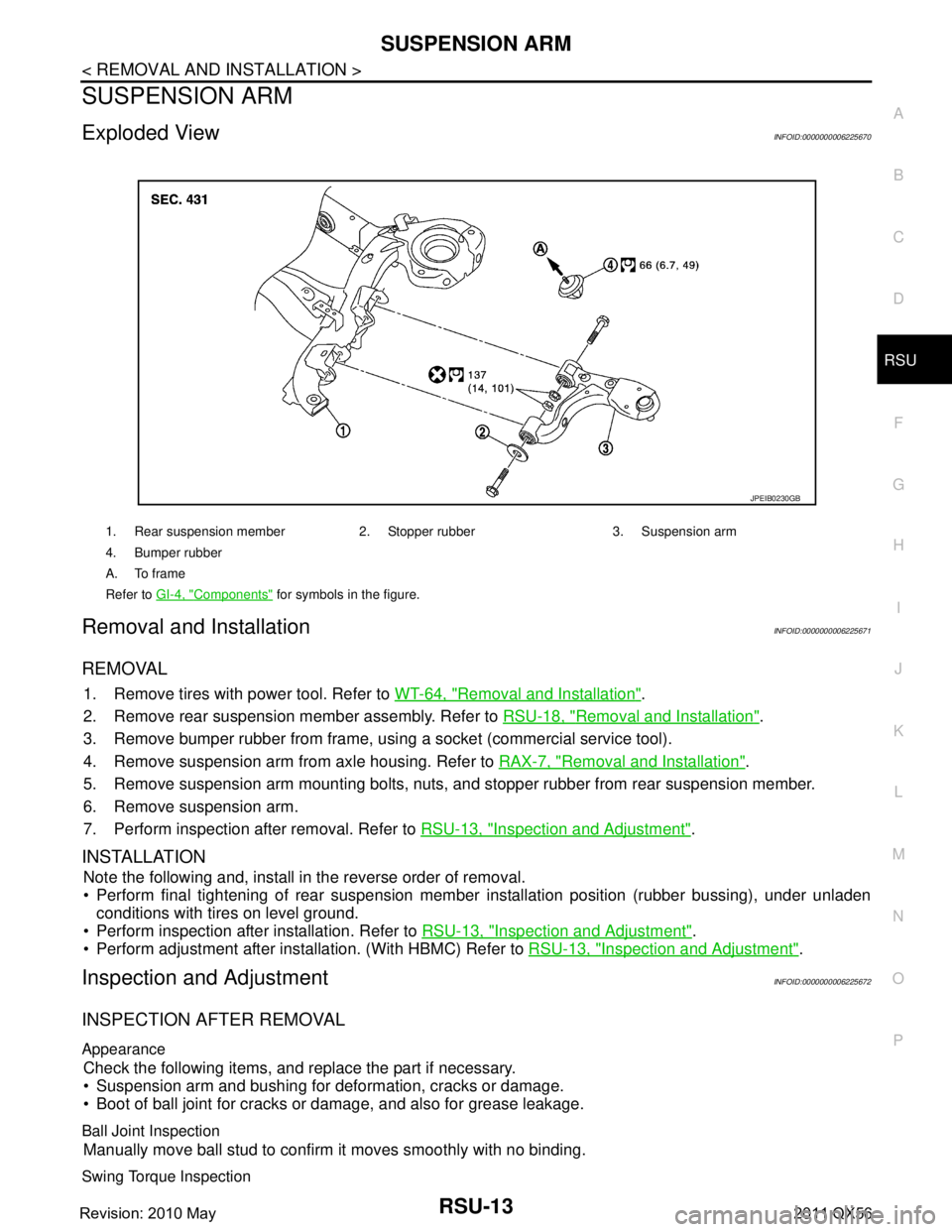
SUSPENSION ARMRSU-13
< REMOVAL AND INSTALLATION >
C
DF
G H
I
J
K L
M A
B
RSU
N
O P
SUSPENSION ARM
Exploded ViewINFOID:0000000006225670
Removal and InstallationINFOID:0000000006225671
REMOVAL
1. Remove tires with power tool. Refer to WT-64, "Removal and Installation".
2. Remove rear suspension member assembly. Refer to RSU-18, "
Removal and Installation".
3. Remove bumper rubber from frame, usi ng a socket (commercial service tool).
4. Remove suspension arm from axle housing. Refer to RAX-7, "
Removal and Installation".
5. Remove suspension arm mounting bolts, nuts, and stopper rubber from rear suspension member.
6. Remove suspension arm.
7. Perform inspection after removal. Refer to RSU-13, "
Inspection and Adjustment".
INSTALLATION
Note the following and, install in the reverse order of removal.
Perform final tightening of rear suspension mem ber installation position (rubber bussing), under unladen
conditions with tires on level ground.
Perform inspection after installation. Refer to RSU-13, "
Inspection and Adjustment".
Perform adjustment after installation. (With HBMC) Refer to RSU-13, "
Inspection and Adjustment".
Inspection and AdjustmentINFOID:0000000006225672
INSPECTION AFTER REMOVAL
Appearance
Check the following items, and replace the part if necessary.
Suspension arm and bushing for deformation, cracks or damage.
Boot of ball joint for cracks or damage, and also for grease leakage.
Ball Joint Inspection
Manually move ball stud to confirm it moves smoothly with no binding.
Swing Torque Inspection
1. Rear suspension member 2. Stopper rubber 3. Suspension arm
4. Bumper rubber
A. To frame
Refer to GI-4, "
Components" for symbols in the figure.
JPEIB0230GB
Revision: 2010 May2011 QX56
Page 4270 of 5598
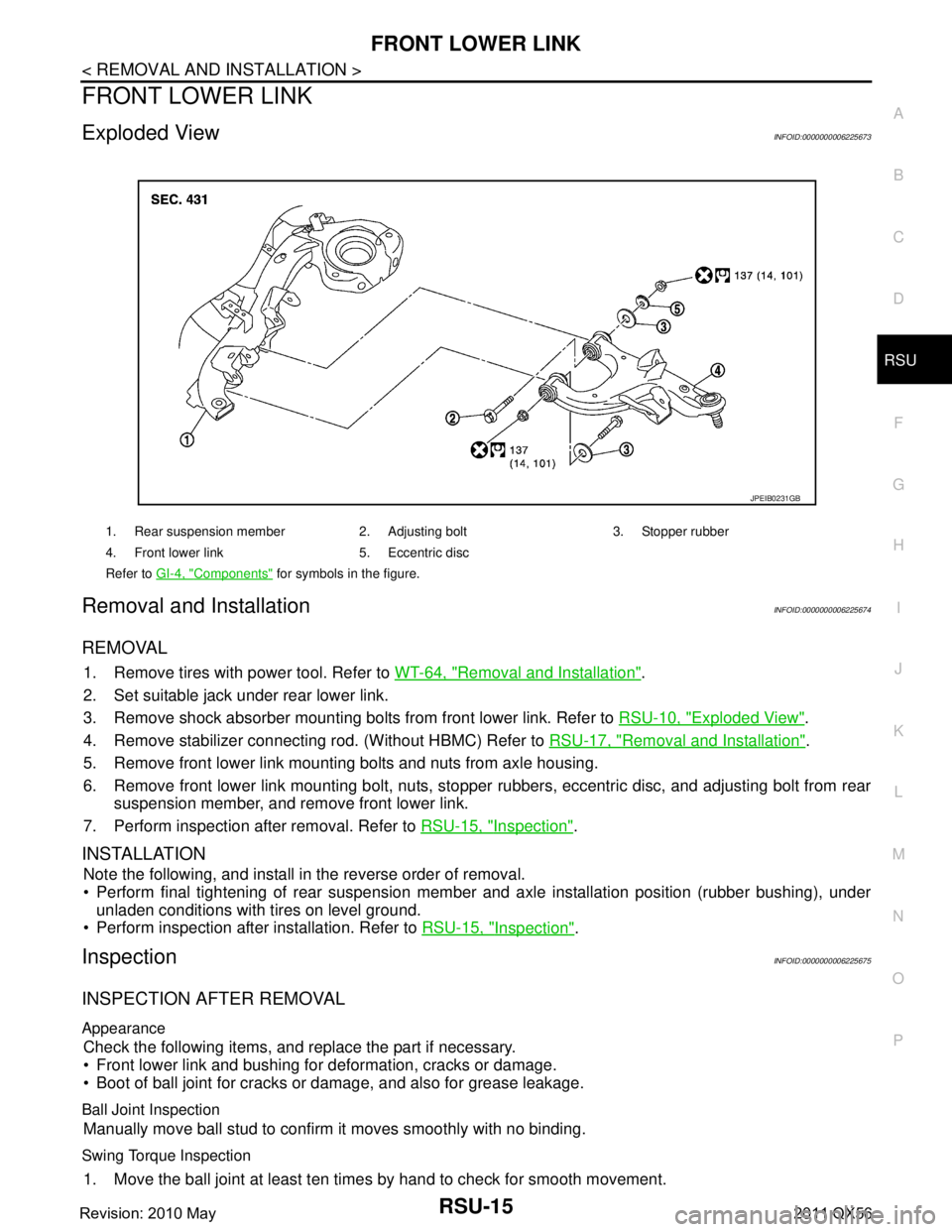
FRONT LOWER LINKRSU-15
< REMOVAL AND INSTALLATION >
C
DF
G H
I
J
K L
M A
B
RSU
N
O P
FRONT LOWER LINK
Exploded ViewINFOID:0000000006225673
Removal and InstallationINFOID:0000000006225674
REMOVAL
1. Remove tires with power tool. Refer to WT-64, "Removal and Installation".
2. Set suitable jack under rear lower link.
3. Remove shock absorber mounting bolts from front lower link. Refer to RSU-10, "
Exploded View".
4. Remove stabilizer connecting rod. (Without HBMC) Refer to RSU-17, "
Removal and Installation".
5. Remove front lower link mounting bolts and nuts from axle housing.
6. Remove front lower link mounting bolt, nuts, stopper rubbers, eccentric disc, and adjusting bolt from rear
suspension member, and remove front lower link.
7. Perform inspection after removal. Refer to RSU-15, "
Inspection".
INSTALLATION
Note the following, and install in the reverse order of removal.
Perform final tightening of rear suspension mem ber and axle installation position (rubber bushing), under
unladen conditions with tires on level ground.
Perform inspection after installation. Refer to RSU-15, "
Inspection".
InspectionINFOID:0000000006225675
INSPECTION AFTER REMOVAL
Appearance
Check the following items, and replace the part if necessary.
Front lower link and bushing for deformation, cracks or damage.
Boot of ball joint for cracks or damage, and also for grease leakage.
Ball Joint Inspection
Manually move ball stud to confirm it moves smoothly with no binding.
Swing Torque Inspection
1. Move the ball joint at least ten times by hand to check for smooth movement.
1. Rear suspension member 2. Adjusting bolt 3. Stopper rubber
4. Front lower link 5. Eccentric disc
Refer to GI-4, "
Components" for symbols in the figure.
JPEIB0231GB
Revision: 2010 May2011 QX56
Page 4273 of 5598
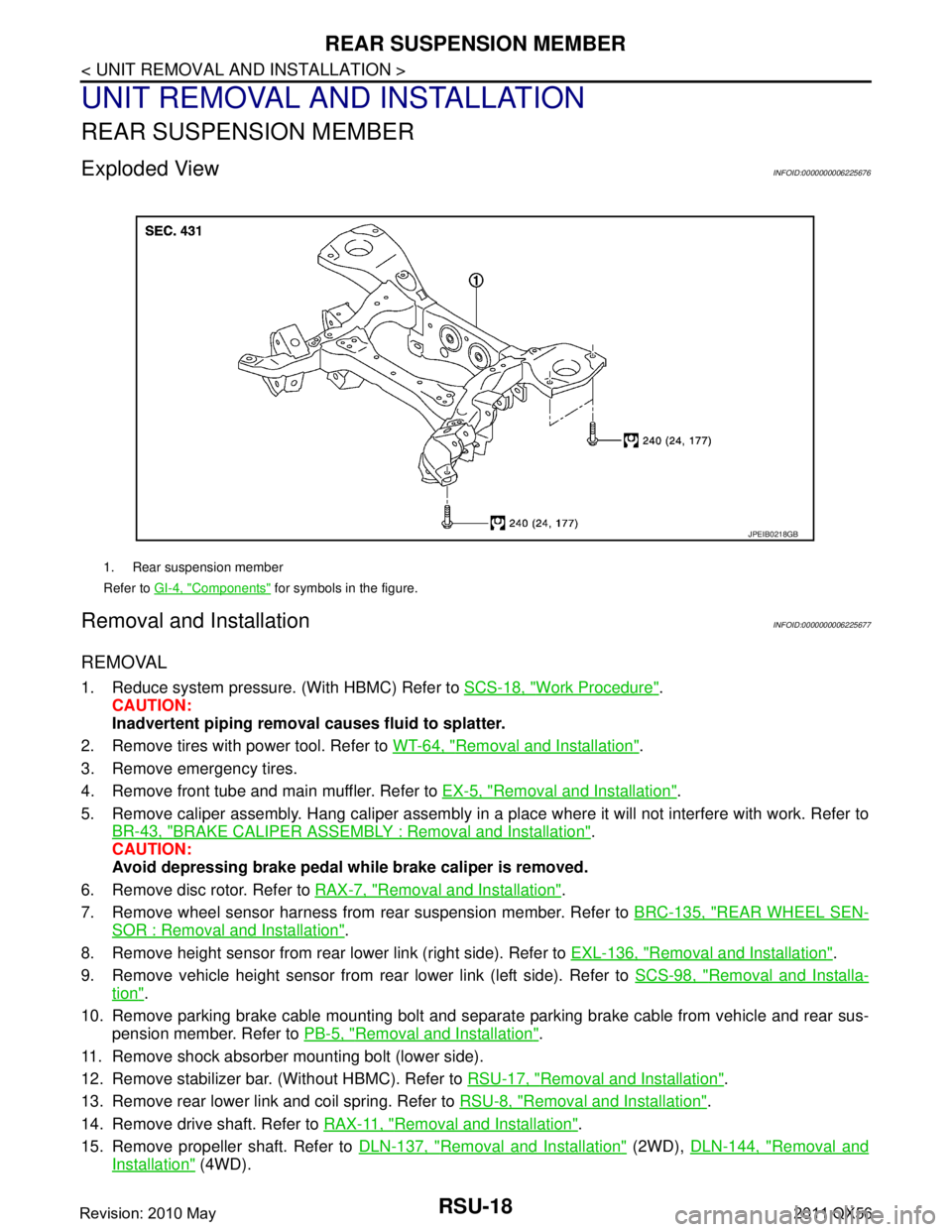
RSU-18
< UNIT REMOVAL AND INSTALLATION >
REAR SUSPENSION MEMBER
UNIT REMOVAL AND INSTALLATION
REAR SUSPENSION MEMBER
Exploded ViewINFOID:0000000006225676
Removal and InstallationINFOID:0000000006225677
REMOVAL
1. Reduce system pressure. (With HBMC) Refer to SCS-18, "Work Procedure".
CAUTION:
Inadvertent piping removal causes fluid to splatter.
2. Remove tires with power tool. Refer to WT-64, "
Removal and Installation".
3. Remove emergency tires.
4. Remove front tube and main muffler. Refer to EX-5, "
Removal and Installation".
5. Remove caliper assembly. Hang caliper assembly in a place where it will not interfere with work. Refer to BR-43, "
BRAKE CALIPER ASSEMBLY : Removal and Installation".
CAUTION:
Avoid depressing brake pedal wh ile brake caliper is removed.
6. Remove disc rotor. Refer to RAX-7, "
Removal and Installation".
7. Remove wheel sensor harness from rear suspension member. Refer to BRC-135, "
REAR WHEEL SEN-
SOR : Removal and Installation".
8. Remove height sensor from rear lower link (right side). Refer to EXL-136, "
Removal and Installation".
9. Remove vehicle height sensor from rear lower link (left side). Refer to SCS-98, "
Removal and Installa-
tion".
10. Remove parking brake cable mounting bolt and separa te parking brake cable from vehicle and rear sus-
pension member. Refer to PB-5, "
Removal and Installation".
11. Remove shock absorber mounting bolt (lower side).
12. Remove stabilizer bar. (Without HBMC). Refer to RSU-17, "
Removal and Installation".
13. Remove rear lower link and coil spring. Refer to RSU-8, "
Removal and Installation".
14. Remove drive shaft. Refer to RAX-11, "
Removal and Installation".
15. Remove propeller shaft. Refer to DLN-137, "
Removal and Installation" (2WD), DLN-144, "Removal and
Installation" (4WD).
1. Rear suspension member
Refer to GI-4, "
Components" for symbols in the figure.
JPEIB0218GB
Revision: 2010 May2011 QX56
Page 4369 of 5598
![INFINITI QX56 2011 Factory Service Manual
STRUCTURE AND OPERATIONSCS-9
< SYSTEM DESCRIPTION > [HBMC]
C
D
F
G H
I
J
K L
M A
B
SCS
N
O P
STRUCTURE AND OPERATION
Hydraulic Body-Moti on Control SystemINFOID:0000000006256001
Shock AbsorberINFOID: INFINITI QX56 2011 Factory Service Manual
STRUCTURE AND OPERATIONSCS-9
< SYSTEM DESCRIPTION > [HBMC]
C
D
F
G H
I
J
K L
M A
B
SCS
N
O P
STRUCTURE AND OPERATION
Hydraulic Body-Moti on Control SystemINFOID:0000000006256001
Shock AbsorberINFOID:](/manual-img/42/57033/w960_57033-4368.png)
STRUCTURE AND OPERATIONSCS-9
< SYSTEM DESCRIPTION > [HBMC]
C
D
F
G H
I
J
K L
M A
B
SCS
N
O P
STRUCTURE AND OPERATION
Hydraulic Body-Moti on Control SystemINFOID:0000000006256001
Shock AbsorberINFOID:0000000006256002
The use of accumulator-generated pressure responsive to driving conditions or pressure generated by oil flow
to the upper/lower chamber improves the steering stabili ty at curving, in addition to the running performance
and a ride quality during off-road travel.
FRONT SIDE
Oil enters from oil inlet outlet hole (A) and flows into lower chamber (3) via outside oil path of cylinder inside.
Oil enters from oil inlet outlet hole (B) and flows into upper chamber (1). With the pressure difference between
oil flowed into the upper chamber and lower chamber, the piston (2) moves up and down and conveys a force
generated through this motion to the tires.
1. Middle tube assembly RH 2. Accumulator assembly RH 3. Front tube assembly A
4. Front tube assembly B 5. Accumulator assembly LH 6. PPMU pipe A
7. PPMU assembly 8. Middle tube assembly LH 9. PPMU pipe B
10. Rear tube assembly A 11. Rear tube assembly B
:Vehicle front
JSEIA0228ZZ
Revision: 2010 May2011 QX56
Page 4370 of 5598
![INFINITI QX56 2011 Factory Service Manual
SCS-10
< SYSTEM DESCRIPTION >[HBMC]
STRUCTURE AND OPERATION
REAR SIDE
Oil enters from oil inlet outlet hole (A) and flows into upper
chamber (1). Oil enters from oil inlet outlet hole (B)
and flows INFINITI QX56 2011 Factory Service Manual
SCS-10
< SYSTEM DESCRIPTION >[HBMC]
STRUCTURE AND OPERATION
REAR SIDE
Oil enters from oil inlet outlet hole (A) and flows into upper
chamber (1). Oil enters from oil inlet outlet hole (B)
and flows](/manual-img/42/57033/w960_57033-4369.png)
SCS-10
< SYSTEM DESCRIPTION >[HBMC]
STRUCTURE AND OPERATION
REAR SIDE
Oil enters from oil inlet outlet hole (A) and flows into upper
chamber (1). Oil enters from oil inlet outlet hole (B)
and flows into lower chamber (3) via outside oil path of cylinder inside. With the pressure difference between
oil flowed into the upper chamber and lower chamber, the piston (2) moves up and down and conveys a force
generated through this motion to the tires.
PPMUINFOID:0000000006256003
PPMU stands for Passive Pressure Maintenance Unit.
System pressure increases according to increase of oil volume due to oil temperature increase. Sudden rise in system pressure can be controlled by feeding the increased oil into the PPMU.
Oil flows into oil chamber via PPMU pipe A and PPM U pipe B by influence of pressure change, pushes gas
spring of nitrogen gas, and pools.
1. Upper chamber 2. Piston 3. Lower chamber
A. Oil inlet outlet hole B. Oil inlet outlet hole
: Vehicle upper
JSEIA0173ZZ
1. Upper chamber 2. Piston 3. Lower chamber
A. Oil inlet outlet hole B. Oil inlet outlet hole
:Vehicle upper
JSEIA0245ZZ
Revision: 2010 May2011 QX56